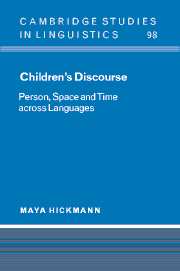Book contents
- Frontmatter
- Contents
- List of figures
- List of tables
- Preface
- List of abbreviations and conventions
- 1 Introduction
- Part I AVAILABLE THEORIES AND DATA
- Part II A CROSS-LINGUISTIC STUDY OF CHILDREN'S NARRATIVES
- 7 Methodological issues
- 8 Animate entities
- 9 Space
- 10 Time
- 11 Conclusions
- Appendix
- Notes
- References
- Author index
- Subject index
9 - Space
from Part II - A CROSS-LINGUISTIC STUDY OF CHILDREN'S NARRATIVES
Published online by Cambridge University Press: 22 September 2009
- Frontmatter
- Contents
- List of figures
- List of tables
- Preface
- List of abbreviations and conventions
- 1 Introduction
- Part I AVAILABLE THEORIES AND DATA
- Part II A CROSS-LINGUISTIC STUDY OF CHILDREN'S NARRATIVES
- 7 Methodological issues
- 8 Animate entities
- 9 Space
- 10 Time
- 11 Conclusions
- Appendix
- Notes
- References
- Author index
- Subject index
Summary
This chapter examines a variety of linguistic devices expressing motion and location in the narratives. As we saw (Chapter 6), previous developmental studies have shown the role of general cognitive factors in children's organisation of spatial information in discourse, as well as the impact of language-specific factors from the youngest ages onwards. Recall (Chapter 3) that languages belong to typologically distinct families with respect to the encoding of motion events (Talmy 1983, 1985, 2000). Satellite-framed languages (English, German, and Chinese in the present sample) represent the manner of motion in the main verb root, while compactly expressing other types of information by means of satellites (such as particles, prepositions, complex verb constructions). In contrast, verb-framed languages (French in the present sample) encode path information in the verb root, while manner, if it is at all expressed, is encoded in the periphery of the clause. The analyses below first examine the situation types denoted by various predicates across languages (Section 9.1). I then examine the ways in which spatial grounds are mentioned in discourse, focusing first on the overall explicitness of these mentions (Section 9.2), then on the first mention of these entities in discourse (Section 9.3) and on subsequent reference-maintenance (Section 9.4). It is concluded (Section 9.5) that sentence factors (grammaticalisation or lexicalisation) and discourse factors (the status of spatial information) both affect children's uses of spatial devices, resulting in invariant, as well as language-specific developmental patterns.
- Type
- Chapter
- Information
- Children's DiscoursePerson, Space and Time across Languages, pp. 240 - 281Publisher: Cambridge University PressPrint publication year: 2002



